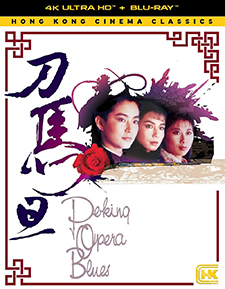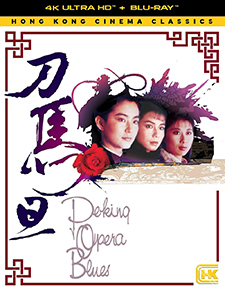Peking Opera Blues (4K UHD Review)

Director
Tsui HarkRelease Date(s)
1986 (September 23, 2025)Studio(s)
Cinema City/Golden Princess (Shout! Studios – Hong Kong Cinema Classics #7)- Film/Program Grade: B+
- Video Grade: A-
- Audio Grade: B
- Extras Grade: B+
Review
Tsui Hark’s Peking Opera Blues (aka Do ma daan) opens with a credit sequence that features male Peking Opera performers in full costume and elaborate makeup. They’re looking directly into the camera as they show off their regalia, and one of them launches into a robust belly laugh as the title song starts to play:
“Raise your head to look
Seize this moment to enjoy a laugh
Look around this world
It’s a drama playing out
I struggle to choose which path to go”
The struggle to decide which path to take can be read on multiple levels in Peking Opera Blues. It’s set in 1913, two years after the 1911 Democratic revolution had ended the final imperial dynasty. Rival groups that had been united in opposition to the Qing dynasty were now vying for dominance in the post-revolutionary environment—and the dynasty itself wasn’t quite willing to give up yet, either. While the film doesn’t address any of that directly, it’s still important background to understand the actions taken by some of the characters. Yet while the political stakes in Peking Opera Blues are undeniable, the film is far more interested in the personal stakes for its three lead characters, each of whom is seizing the moment in order to make revolutionary personal and social changes.
It’s significant that Peking Opera Blues opens with a group of male performers, because just like with Elizabethan theatre, most of the roles in Chinese opera were played by men—the female roles included. Bai Niu (Sally Yeh) is an aspiring performer who chafes against these kinds of arbitrary restrictions, much to the consternation of her father Mr. Wong (Wu Ma), who happens to own the troupe in which she wants to perform. Meanwhile, Tsao Wan (Brigitte Lin) is the daughter of General Tsao (Kenneth Tsang). He’s been amassing wealth in order to help restore the Qing dynasty, but unbeknownst to him, she’s secretly working for the revolutionary forces. Equally significantly, she prefers androgynous garb, wearing male clothing with her hair cut short. The odd woman out in this trio is Cherie Chung (Sheung Hung), an itinerant musician whose primary desire is making money by any means necessary. The only revolution that interests her is survival.
Raymond Tso’s script for Peking Opera Blues wastes little time setting these three women on a collision course with each other. In the early stages, the story is somewhat farcical, almost feeling like A Funny Thing Happened on the Way to the Peking Opera in terms of the way that absurdity is piled on top of absurdity. (Seize these moments to enjoy a laugh.) There are plenty of elaborate twists and turns, but all of the plot dynamics exist to bring the women closer together, reluctantly at first, but they increasingly start to rely on each other. As that happens, Tso and Hark start to raise the stakes for them, and their personal revolutions inevitably become more political.
That’s because Peking Opera Blues uses its political machinations in order to explore gender roles and gender identity, flipping the script not just on Chinese opera but on Hong Kong cinema in general. Bai Niu doesn’t accept the fact that she’s not allowed to perform in a male dominated milieu, and she’s doggedly determined to make her own way regardless of any opposition that she faces—her own father included. Tsao Wan isn’t willing to accept subservient female roles in general, both socially and stylistically. Bai Niu wants to be able to play a woman on stage, where women are usually played by men in female garb, while Tsao Wan doesn’t want to settle for the traditional female roles that society has tried to impose on her, and so she dresses in male garb instead. Even Cherie Chung isn’t willing to accept being treated as little more than a courtesan, so she’s willing to risk everything in order to make her own way in the world.
Despite the historical setting, in many ways, Peking Opera Blues can be read as one of the “women with guns” films that rose to prominence in Hong Kong cinema during the latter half of the Eighties. The action in the film relies more on wuxia acrobatics than on gunplay, but these are still women who are choosing which path to take in a world where the patriarchy is trying to restrict their opportunities. And, they kick ass when necessary. Yet the historical setting is important, because as all three women go their own separate ways after the finale, a title card appears to remind viewers that five months later, parliament was dissolved and Yuan Shikai declared himself to be the new emperor, starting the revolution all over again.
For Bai Niu, Tsao Wan, Cherie Chung, and many, many more women and men alike, the struggle will continue.
Cinematographer Hang-Sang Poon shot Peking Opera Blues on 35m film using spherical lenses, framed at 1.85:1 for its theatrical release. This version is based on a 4K scan of the original camera negative, cleaned up and graded for High Dynamic Range in Dolby Vision and HDR10. The optically printed opening credit sequence was derived from dupe elements and displays the expected softness, but once they’re over... well, the image does tighten up, but only incrementally. That’s because Poon employed diffusion throughout the film, using filters at a minimum and possibly even silks in a few shots, in order to achieve a hazy, period look. Everything does look as crisp and clear as it can, but it’s important to adjust your expectations with the understanding of what Poon and Hark intended. Regardless, it’s still sharp enough that the matte paintings now stand out more than they ever have before. Yet the biggest beneficiary to the 4K treatment is probably the grain structure, which is genuinely tight and refined.
The HDR grade offers benefits as well, though perhaps not in the way that you might expect. Peking Opera Blues is a colorful film in terms of the wildly variegated tones on display in any given scene, especially those that take place within the opera house, but befitting the intentionally hazy look, those colors aren’t necessarily vivid. It’s the breadth of the colors that have been brought out thanks to Wide Color Gamut that’s the real selling point here. Nothing has been dialed up or oversaturated, but the shading is rich and well-defined. Look no further than the rose-pink face paint on the performers, which isn’t really monochromatic, but rather contains some subtle variations within those pinks, all of which stand out more in HDR than they do in SDR. Peking Opera Blues may not be the most dazzling 4K presentation, but it’s an accurate one, and that’s what counts.
Audio is offered in Cantonese and English mono DTS-HD Master Audio, with optional English subtitles. Both tracks are mixed with typical Hong Kong cinema dynamics, which is to say, none whatsoever. It’s loud and compressed throughout, enough so that there’s some audible distortion. The dubbed dialogue (regardless of language) is forward in the mix and doesn’t integrate well into the soundstage, but once again, that’s typical of Hong Kong films from the era. It’s still serviceable. The newly-translated English subtitles are unquestionably an improvement over previous versions, and while I can’t comment on their accuracy, they work well enough.
The Shout! Studios 4K Ultra HD release of Peking Opera Blues is #7 in their Hong Kong Cinema Classics line. It’s a two-disc set that includes a Blu-ray with a 1080p copy of the film, as well as a slipcover that duplicates the artwork on the insert. The following extras are included, all of them in HD:
DISC ONE: UHD
- Commentary by James Mudge
DISC TWO: BD
- Commentary by James Mudge
- An Opus for Peking (21:58)
- An Operatic Achievement (11:11)
- Hong Kong Confidential (14:22)
- Peking Provocations (25:02)
- Peking History Blues (23:42)
- Theatrical Trailer (2:27)
- Image Gallery (10:57)
The new commentary features James Mudge, head writer for the easternKicks website, who enthusiastically delves into Peking Opera Blues and the state of Hong Kong cinema at the time it was produced. He covers the careers of Tsui Hark and all the lead actors, as well as many of the supporting actors, and also explores the film thematically, tonally, and stylistically. In fact, there’s not many stones that he leaves unturned, since Mudge is perfectly capable of giving Frank Djeng a run for his money in terms of talking nonstop without ever taking a breath. It’s not really a scene-specific track since Mudge free associates and follows his muse wherever it may lead him, only occasionally taking the time to discuss what’s happening onscreen. It’s still an entertaining track that’s packed with information.
The rest of the extras consist of new interviews, the film’s trailer, and an extended Image Gallery. The first two interviews are with participants in the making of Peking Opera Blues, while the remainder are analytical. An Opus for Peking is with Mark Cheng, who breaks down his career and his involvement with Peking Opera Blues—which was a little more complicated than it may seem on the surface. An Operatic Achievement is with cinematographer Ray Wong Chi-Wai, he served as a focus puller on Peking Opera Blues. He was a fan of Tsui Hark before he became involved with the film, so it was a great experience for him.
Hong Kong Confidential is with Grady Hendrix, co-author of These Fists Break Bricks. He provides an overview of where Peking Opera Blues fits into Hark’s career, and also explores the way that it inverted the gender dynamics in Hong Kong comedies and Peking Opera. Peking Provocations is with David West, author of Chasing Dragons: An Introduction To The Martial Arts Film. He also discusses where Peking Opera Blues fits into Hark’s filmography, but he goes into even greater depth regarding the way that it explores gender dynamics. He breaks down all three lead characters, especially Tsao Wan, who he considers the female equivalent of a knight errant, defining the film’s main themes of chivalry, righteousness, and patriotism. Finally, Peking History Blues is with Dr. Lars Laamann, author and associate professor at SOAS University in London. He goes deep background, detailing the chaotic development of factions in China after the 1911 revolution, providing details about the time period and how they relate to the story in Peking Opera Blues. In addition, he spends some time delving into exactly what the film’s original title Do ma daan means to the narrative.
Considering that most of the previous home video releases of Peking Opera Blues have been bare bones (aside from a couple of brief interviews that were on a Hong Kong DVD), that’s a substantial upgrade in terms of extras. They’re all interesting, with the commentary and the Lars Laamann interview being particularly valuable. And, needless to say, this is a significant upgrade in terms of video quality as well (even if it still can’t be the sharpest 4K presentation on the market). It’s a great release from Shout! Studios, and another fantastic addition to their Hong Kong Cinema Classics line. Regardless of what may (or may not) happen with the company in the future, they’re still doing great work today, and this one is highly recommended.
-Stephen Bjork
(You can follow Stephen on social media at these links: Twitter, Facebook, BlueSky, and Letterboxd).

